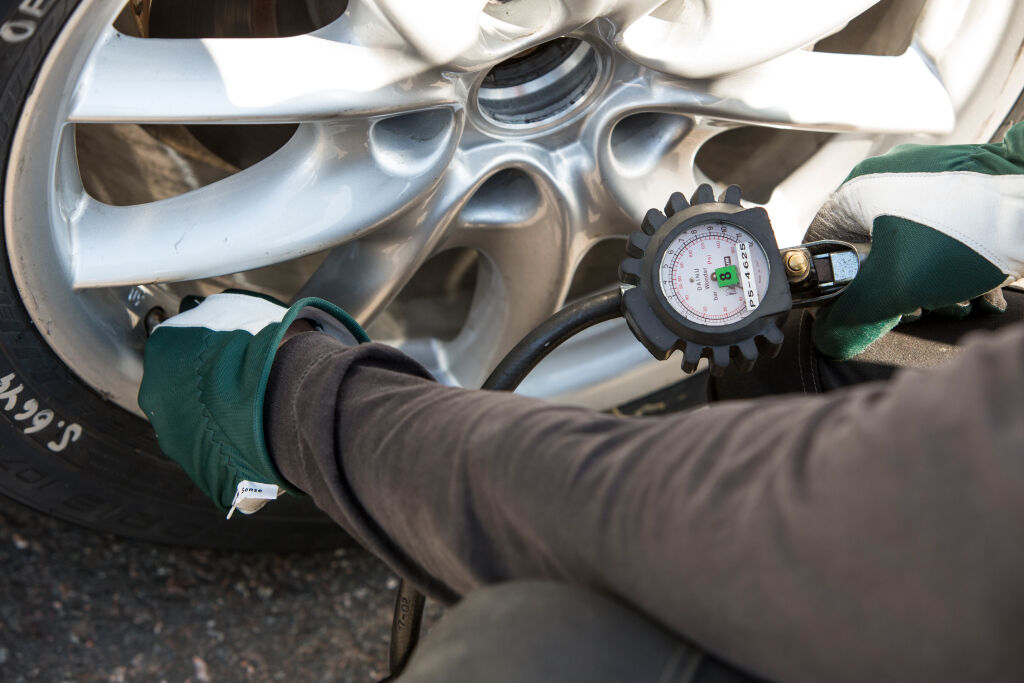
Driving with the right tire pressure is better for both your tires and safety in traffic. Here’s how to check air pressure from your tires and why summer and winter tires have different tire pressures.
What is the recommended tire pressure for summer and winter tires
Temperature has a significant impact on tire pressurization. We recommend using the vehicle manufacturer’s suggested tire pressure for summer tires. For winter tires, you should inflate the tires to 3 PSI above the summer tire recommendation since tire pressure decreases as much as 1 PSI with each 10-degree drop in temperature. The temperature in a warm garage can be up to 15 ºC higher than outside. If the tire pressure is measured inside, it will be too low for outside temperatures.
Example: The temperature in the garage is 20 ºC, while the outside temperature is -9 ºC. If the pressure is adjusted in the garage, the pressure added to the tires must be 3 PSI higher than the recommended value to ensure a correct pressure level outside.
How to check tire pressure
Each car owner benefits from knowing how to check tire pressure and use a tire pressure gauge. The benefits of using proper tire pressure include even wear, less tire noise, improved performance and safety, better fuel economy, as well as longer service life. Maintaining the correct air pressure in your tires is essential for optimal performance and safety on the road. Properly inflated tires ensure a smooth and secure driving experience.
Here’s how to check tire pressure using a tire pressure gauge:
- Checking your tires' air pressure starts with the vehicle manufacturer’s recommendation for tire inflation. For instance, you can find the recommended air pressure from the owner’s manual and driver-side door.
- Check tire pressure from cold tires. Driving causes the tires to heat up, so wait a while before checking your tires' air pressure to see if they are still warm from driving.
- Remove the tire’s valve cap and insert the tire pressure gauge. There are different types of tire pressure gauges, so make sure to get familiar with the one you are using to get an accurate measurement.
- Press the tire pressure gauge, and you should hear a hissing sound. Once the sound disappears, check the reading of the gauge. Compare the reading to the vehicle’s recommended tire pressure.
- Adjust the air pressure to the recommended level with an air compressor if needed. You can find an air compressor and a tire pressure gauge at a gas or service station.
- Repeat the process for all four tires, and make sure to check your tire pressure regularly. Remember to check your spare tire as well.
Modern cars are equipped with a tire pressure monitoring system (TPMS) , which makes monitoring your tire pressure much easier. With TPMS, a tire pressure light turns on when the pressure drops and warns the driver. When the light turns on, you know it’s time to check the tire pressure.
More safety and longer service life with correct air pressure
In addition to correct tire pressure, drivers should also ensure that uni-directional tires are correctly installed on the car. The arrow on the sidewall indicates the rolling direction.
To prolong the lifetime of the tires, rotate them regularly. Front and rear tires can be changed from one axle to another every 4,800-8,000 kilometers. As a result, the tires will wear evenly and show smaller differences in wear.
Tires marked M+S (intended for winter use) should be carefully broken in. For the first 500 km (about 300 miles), avoid sudden acceleration and braking. A gentle break-in improves the durability of studding: the studs will fit securely into place and stay on the tires.
Take care of your tires and improve road safety by using the recommended tire pressure and remember the effect outside temperature has on the tire pressure level. When it’s time to change to new tires, visit your local Nokian Tyres dealer for premium all weather tires, all terrain tires, winter tires and all season tires.
Please remember that it is the driver’s responsibility to ensure their tires are safe and suitable for their vehicle and to follow the vehicle’s manufacturer´s guidelines for proper use and maintenance. Consult your closest Nokian Tyres dealer or your vehicle’s manufacturer for specific advice.


